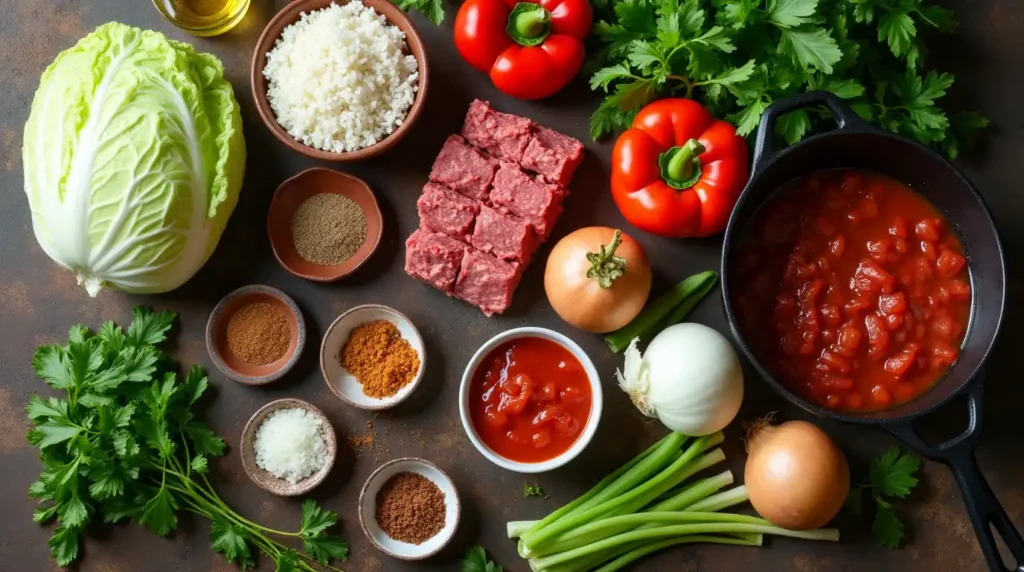Table of Contents
Creole Cabbage Rolls are a savory and satisfying dish rooted in Southern culinary traditions. Combining tender cabbage leaves, a hearty meat and rice filling, and bold Creole spices, this dish is a perfect representation of Louisiana comfort food. Whether you’re preparing a weeknight dinner or feeding a crowd, Creole Cabbage Rolls bring warmth and spice to the table.
The Origins of Creole Cabbage Rolls
Cabbage rolls have been embraced by cultures around the world from Eastern European to Middle Eastern cuisines but the Creole variation stands out for its spicy, aromatic character. Developed in Louisiana, this version integrates Creole seasoning, bell peppers, onions, and sometimes sausage or shrimp for a deeper flavor.
Creole cuisine is a blend of French, Spanish, African, and Caribbean influences, and this dish showcases that rich fusion. For a great traditional recipe, you can reference Tony Chachere’s Creole Cabbage Rolls, which uses classic ingredients with bold seasoning. For a slightly different take, Zatarain’s version offers a simple preparation that highlights their signature spice blends.
Essential Ingredients for Creole Cabbage Rolls

To prepare authentic Creole Cabbage Rolls, start with these staple ingredients:
- Green cabbage (whole head, for leaves)
- Ground beef or a mix of ground beef and pork
- Cooked white rice
- Onion, finely chopped
- Bell pepper (typically green or red)
- Celery, finely chopped
- Garlic, minced
- Creole seasoning (store-bought or homemade)
- Crushed tomatoes or tomato sauce
- Chicken or vegetable broth
- Worcestershire sauce or hot sauce (optional for extra heat)
For vegetarian or vegan variations, substitute meat with:
- Cooked lentils or black beans
- Chopped mushrooms and quinoa
- Plant-based meat alternatives
Step-by-Step Preparation Guide
Preparing the Cabbage
- Core the cabbage and boil it for 8–10 minutes until the outer leaves are pliable.
- Peel off 10–12 whole leaves carefully and set aside.
Making the Filling
- In a bowl, mix:
- 1 lb ground meat
- 1 cup cooked rice
- 1/2 cup each chopped onion and bell pepper
- 2 minced garlic cloves
- 1 tbsp Creole seasoning
- Optional: dash of hot sauce or Worcestershire

Assembling the Rolls
- Lay a cabbage leaf flat.
- Spoon 2–3 tablespoons of filling near the stem end.
- Fold the sides over and roll tightly.
- Repeat with remaining leaves and filling.
Cooking the Rolls
- In a deep skillet or Dutch oven:
- Spread a layer of tomato sauce or crushed tomatoes.
- Arrange cabbage rolls seam-side down.
- Pour additional tomato sauce and broth over the rolls.
- Cover and simmer on low heat for 45 minutes, or bake at 350°F for 1 hour.
Flavor Variations and Enhancements
For those looking to experiment:
- Use Creole sausage or Andouille in place of ground beef.
- Add chopped shrimp to the filling for a seafood twist.
- Mix in shredded cheese for a creamy, rich interior.
- Sprinkle paprika or cayenne for extra spice.
Popular variations include:
- Vegetarian cabbage rolls with beans and quinoa
- Low-carb versions using cauliflower rice
- Cheese-topped rolls finished in the oven
Serving Suggestions
Creole Cabbage Rolls are filling on their own, but sides can elevate the meal:
- Cornbread or hushpuppies
- Mashed potatoes or dirty rice
- Braised greens or green beans
- A chilled cucumber and tomato salad for contrast
Pair with iced tea, a dry white wine, or a light lager.
Storage and Reheating Tips
Creole Cabbage Rolls store well, making them ideal for meal prep.
- Store in an airtight container in the fridge for up to 5 days.
- Freeze individually on a tray, then transfer to freezer bags.
- Reheat in the oven (covered with foil) at 350°F for 20 minutes, or microwave in 2-minute intervals.

For best texture, avoid over-microwaving, which can make cabbage soggy.
Frequently Asked Questions
What is the sauce on traditional cabbage rolls?
Traditional cabbage rolls are topped with a tomato-based sauce made from crushed or diced tomatoes, tomato paste or sauce, onion, garlic, and sometimes a pinch of sugar to balance acidity. In Creole-style cabbage rolls, the sauce often includes Creole seasoning, hot sauce, and Worcestershire for added depth and spice.
How to make the best cabbage rolls?
Start with fresh, blanched cabbage leaves. Prepare a filling of ground meat (like beef, pork, or sausage), cooked rice, onions, garlic, and seasoning. Use Creole seasoning for bold flavor. Roll tightly, place seam-side down, and cook low and slow in a seasoned tomato sauce, either by simmering or baking. Let them rest after cooking for maximum flavor development.
What is the difference between halupki and golumpki?
Halupki and golumpki are essentially the same dish. “Halupki” is the Slovak-American name, while “golumpki” (or “gołąbki”) is Polish. Both refer to cabbage leaves stuffed with a meat and rice mixture, then baked in tomato sauce.
Which country has the best cabbage rolls?
Many countries lay claim to excellent cabbage rolls. Poland (gołąbki), Ukraine (holubtsi), Romania (sarmale), and Hungary (töltött káposzta) are top contenders. Creole-style cabbage rolls stand out in the U.S. for their bold spice profile and Southern influence.
Do you put sour cream on cabbage rolls?
Yes, sour cream is a traditional topping, especially in Eastern European versions. It adds creaminess and tang to balance the rich tomato sauce. While it’s less common with Creole cabbage rolls, it can still be used to taste.
What is the difference between Polish and Ukrainian cabbage rolls?
Polish cabbage rolls are typically milder, using a tomato-based sauce and a pork-beef filling. Ukrainian versions often include garlic, fresh herbs, and may use both tomato and cream sauces. The differences lie mostly in seasoning and sauce style.
What ethnicity are cabbage rolls?
Cabbage rolls are a global dish. They are common in Polish, Ukrainian, Russian, Romanian, Lebanese, Jewish, German, and even Southern U.S. (Creole) cuisines. Each culture adapts the recipe with regional spices, meats, and sauces.
What is the meat in a cabbage roll called?
There’s no special name for the meat—it’s simply ground meat, typically beef, pork, or turkey, mixed with rice, onion, and spices. In Creole versions, Andouille sausage or shrimp may be added for extra flavor.
What are German cabbage rolls made of?
German cabbage rolls (Kohlrouladen) are filled with ground beef or pork, onion, mustard, and breadcrumbs or rice. They are browned in a pan and then braised in a savory gravy or tomato-onion sauce.
How do you make lazy man’s cabbage rolls?
Lazy cabbage rolls are a casserole-style dish. Chop cabbage instead of rolling it, mix with seasoned ground meat and rice, layer it with tomato sauce, and bake. It’s faster and easier with the same comforting flavors.
Why do you put baking soda in cabbage?
A small pinch of baking soda may be added while boiling cabbage to preserve its green color and speed up softening. However, it can make cabbage mushy if overused and may affect flavor, so it’s best used sparingly.
How do you keep cabbage crispy when cooking?
To keep cabbage crisp, don’t overboil just blanch for a few minutes and plunge into ice water. Avoid overcooking during the final baking or simmering. Reheat in the oven rather than the microwave to preserve texture.
Conclusion
Creole Cabbage Rolls are more than just a Southern twist on a classic comfort dish—they’re a flavorful celebration of Louisiana’s rich culinary heritage. With their savory filling, tender cabbage leaves, and bold, well-balanced seasoning, these rolls reflect the essence of Creole cooking: resourceful, layered in flavor, and deeply satisfying. Whether you’re new to Creole cuisine or a longtime fan, this dish is approachable enough for beginners and versatile enough for experienced cooks to personalize.
One of the most appealing aspects of Creole Cabbage Rolls is their adaptability. You can tailor them to suit almost any dietary preference or spice level. Swap out ground beef for Andouille sausage, add shrimp for a seafood spin, or go meatless with mushrooms and lentils. This makes them not only delicious but also incredibly flexible for households with different tastes.
The dish also lends itself well to batch cooking and meal prep. You can prepare the rolls ahead of time, freeze them, and reheat with little loss of flavor or texture—making them an excellent option for busy families or anyone planning meals in advance.
Pair them with traditional Southern sides like cornbread or mashed potatoes, and you have a meal that’s both comforting and memorable. Serve them at casual dinners, holiday tables, or potlucks and watch them become a favorite.
In every bite, Creole Cabbage Rolls tell a story of culture, spice, and soul. Try them once, and they may just become a permanent part of your cooking repertoire.
Easy Allrecipes
1-Italian Sausage Parmesan Pasta – Easy, Creamy, and Flavor-Packed
2-Tender Slow-Cooked Beer Braised Beef Tacos Recipe (Easy & Flavorful)
3-10 Secrets to Making the Best Fresh and Tasty Potato Salad
4-Creamy Crab and Shrimp Seafood Bisque – The Ultimate Homemade Recipe
5-Dino Beef Ribs: The Ultimate Guide to Smoking, Seasoning & Serving
6-Street Corn Chicken Rice Bowl – A Smoky, Creamy & Delicious Meal
7-Honeynut Squash Ragu – A Rich & Flavorful Fall Pasta Sauce
8-Garlic Steak Bites and Potatoes | Quick & Easy One-Pan Recipe
9-Sheet Pan Salmon with Asparagus – Easy, Healthy & Delicious Recipe
10-How to Make the Best Salisbury Steak with Mushrooms – Easy & Flavorful Recipe

